15.40.470 Sign standards by sign type.
This section is intended to be used in conjunction with other standards contained in these sign regulations. Signs shall also comply with Section 15.40.430, Illumination. Each sign type shall also comply with design standards Section 15.40.480 in addition to design and quality requirements within the sign standards for each sign type within this section.
A. Wall Signs.
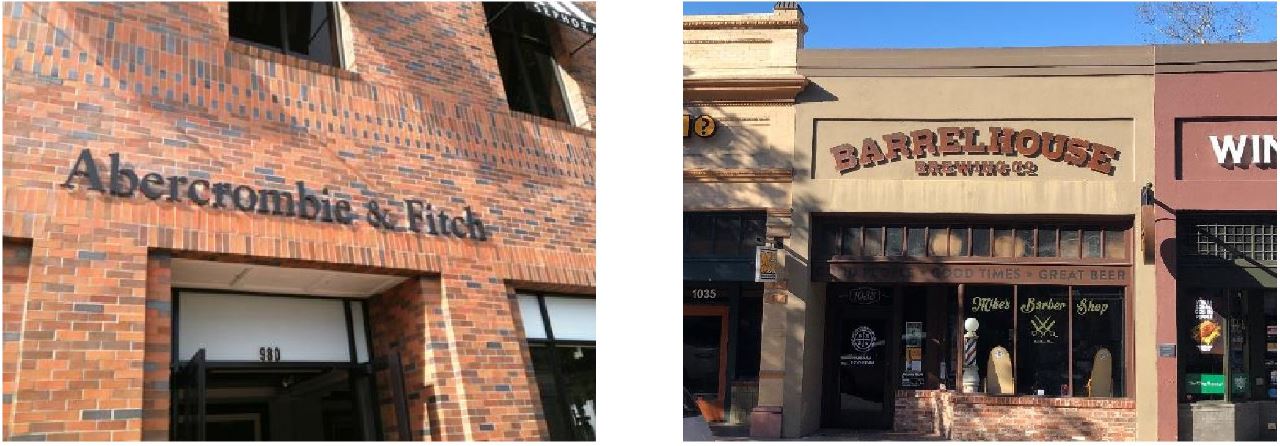
Signage Guidelines
Wall signs include most types of signage that are attached to the face of a building wall. These include channel letters made out of wood, metal or plastic. Wall signs may be painted on a wall, or on a board that is attached to a wall. Wall signs should be oriented to achieve balanced composition and harmony with other architectural elements of a building facade. Wall signs should be placed on a flat building surface and should not be placed over or otherwise obscure architectural building features.
1. Location and Number Permitted. Wall signs shall be located on a building face that has a public entrance (unless allowed, Section 15.40.420). One wall sign is permitted per wall face for each occupant, with up to two per occupant space where conditions of Section 15.40.420 are applicable. The maximum height of wall signs on multi-story buildings is the uppermost point of the second story unless additional height is approved through a sign program or exception as provided in Sections 15.40.485 and 15.40.600.
2. Size. Wall signs may be a maximum of one hundred square feet or fifteen percent of the building face where the sign is attached, whichever is less. Wall signs shall not exceed maximum cumulative areas of Section 15.40.460. The building face area is determined by multiplying the length of the linear frontage of the tenant space or building by the average height of the tenant space or building.
3. Illumination. Wall signs may be illuminated externally or internally consistent with Section 15.40.430 and the design standards set forth in subsection (A)(4) of this section.
4. Design. Internally illuminated cabinet signs are prohibited in the downtown commercial district. Examples of allowed internally illuminated signs include backlighting, halo, or neon lit letters or emblems, channel letters, or logos. All wall signs shall consist of high-quality installations using a direct or flush mount without exposed wiring, raceways, or other stabilizing devices or mounts including backer mounts. Attachments shall be hidden from view in the least destructive manner possible. For masonry, attachments should be embedded into the mortar, not the brick or stone. Except as allowed herein, materials such as foam, poster board, or flat plastic which are usually associated with temporary signage are not appropriate.
a. Balance and Proportion. Wall signs shall appear balanced and in proportion and scale with the building elevations which they are placed, and not obscure windows, or overwhelm architectural features such as pilasters and cornices (see examples shown below).

b. Material. Unless approved as a temporary sign, wall signs shall not consist of materials such as foam, poster board, or flat plastic which are usually associated with temporary signage (see examples below).
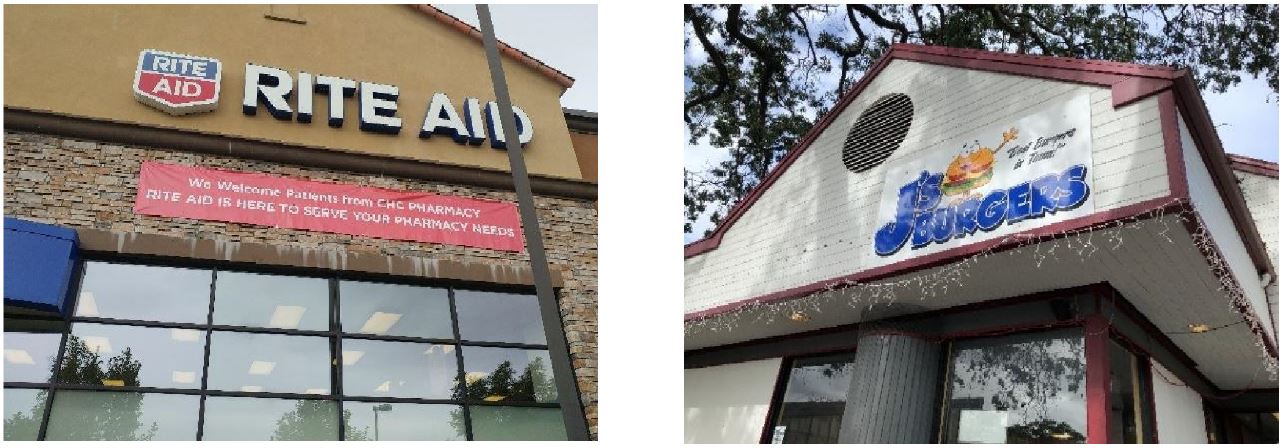
5. Zoning. Wall signs are allowed in all zoning districts.
B. Window Signs.

Signage Guidelines
Window signs should be scaled to the pedestrian and oriented to window shoppers on the sidewalk, as opposed to vehicles passing by. Window signs should be limited to small graphics and text that serve to frame a window or to provide information. A window sign should not obscure the view into a store or place of business.
1. Location and Number. There is no specific location requirement or limit to the number of window signs allowed. Window signs are located within thirty-six inches of the face of a window. Window displays, including merchandise displays, graphics and text, that are located more than thirty-six inches from the face of a window are not considered signs.
2. Size. Window signs are limited to a maximum of twenty-four square feet or fifteen percent of the window area, whichever is less.
3. Illumination. Window signs may be illuminated by any means consistent with Section 15.40.430.
4. Zoning. Window signs are allowed in all commercial zoning districts.
C. Awning Signs.
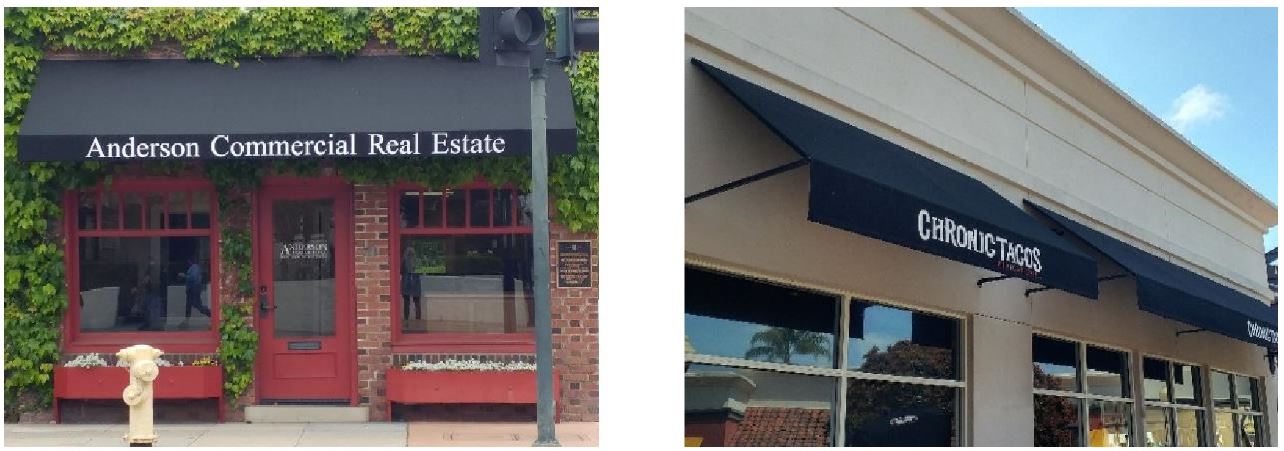
Signage Guidelines
Signs on awnings should be minimized and are only appropriate if there are no good alternatives for wall signs, projecting signs or hanging and suspended signs. Signage should be limited to the skirt of the awning and should not be on the awning face. Signs should only be considered for the awning face if there is no other adequate location for signage on a given storefront or property.
1. Location and Number. Signs may be located on awnings subject to size criteria. One awning sign is permitted per tenant space and must maintain a minimum vertical and horizontal clearance requirement of Section 15.40.440.
2. Size. Signs on awnings shall not cover more than twenty-five percent of the main area of the awning, or exceed twenty-five square feet in size, whichever is smaller.
3. Illumination. Awning signs may be externally illuminated consistent with Section 15.40.430. Backlit, translucent awning signs are prohibited.
4. Design. Graphics, logos, and signage language should have a quality integrated appearance and signage shall not be added to existing awnings with adhesive applications or other means of attaching a sign to the awning material. The awning material should incorporate a durable sign design and consist of long-lasting materials such as canvas or another durable outdoor fabric material.
5. Zoning. Awning signs may be located in all commercial zones.
D. Projecting Signs.
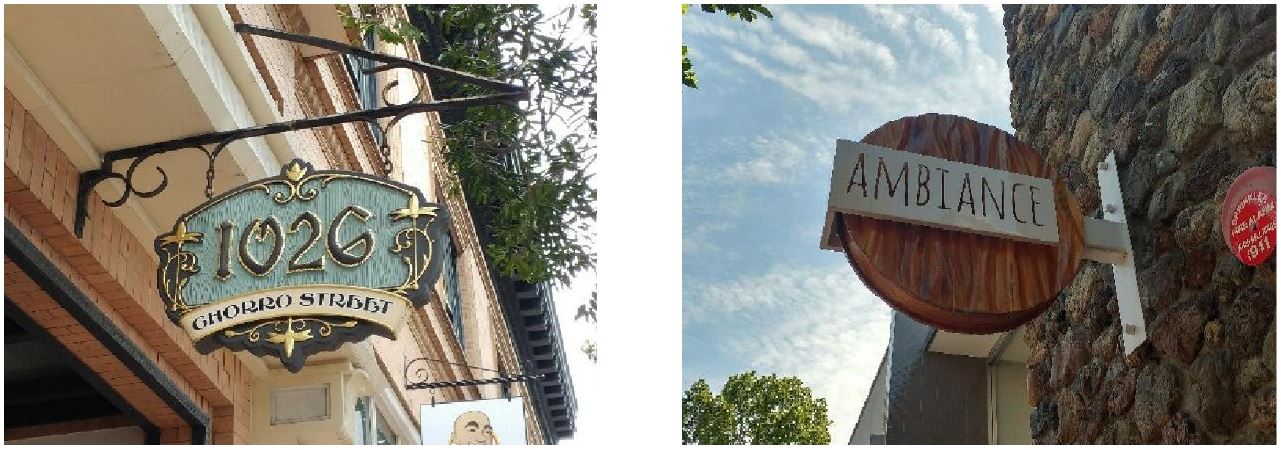
Signage Guidelines
Projecting signs are attached to a building face and project out perpendicular to the building wall. Projecting signs are very effective when oriented to pedestrians on the sidewalk level. Appropriate materials include wood and metal with carved or applied lettering, or any other material that is architecturally compatible with the building that the sign is attached to. Multiple projecting signs should not be installed within ten feet of each other if on the same property and should be separated from projecting signs on adjacent properties by ten feet to ensure proper visibility.
1. Location and Number. Projecting signs must be attached to building facades that have a public entrance and must maintain minimum vertical and horizontal clearance requirements of Section 15.40.440. One projecting sign is allowed per tenant space. Multiple projecting signs shall not be installed within ten feet of each other if on the same property and shall be separated from projecting signs on adjacent properties or tenant spaces by ten feet to ensure proper visibility.
2. Size. Projecting signs may have the following maximum areas:
Office (O) zone: six feet.
Neighborhood commercial (C-N) zone: twelve square feet.
Downtown commercial (C-D) zone: twelve square feet.
Community commercial (C-C) zone: twelve square feet.
Retail commercial (C-R) zone: twenty-four square feet.
Tourist commercial (C-T) zone: twenty-four square feet.
3. Illumination. Projecting signs may be illuminated by any means consistent with Section 15.40.430.
4. Design. Projecting signs shall attach to a building face and project out perpendicular to the building wall. Projecting signs are encouraged as an effective pedestrian scale sign. Appropriate materials include wood and metal with carved or applied lettering, or any other material that is architecturally compatible with the building that the sign is attached. Materials such as foam, poster board, or flat plastic which are usually associated with temporary signage are not appropriate.
5. Zoning. Projecting signs are allowed in the O, C-N, C-D, C-C, C-R and C-T zoning districts only.
E. Hanging and Suspended Signs.
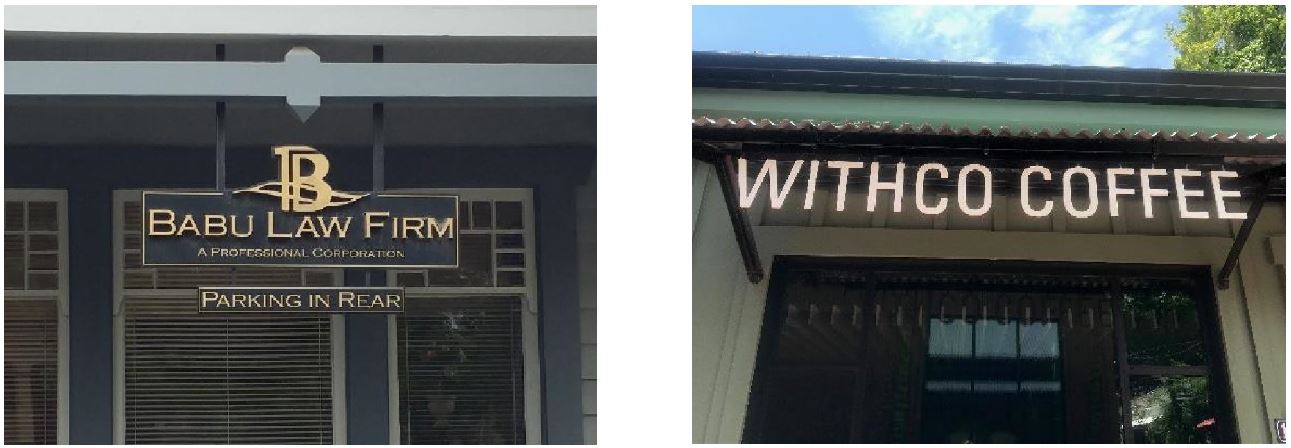
Signage Guidelines
Hanging signs, or suspended signs, are used to help define entries and identify business names to pedestrians. They are small and can hang over a building entry if the appropriate clearance is provided. Hanging signs can be particularly useful for storefronts that have multiple tenants.
1. Location and Number. Hanging or suspended signs shall be attached to building facades that have a public entrance and must maintain minimum vertical and horizontal clearance requirements of Section 15.40.440. One hanging or suspended sign is allowed per tenant space.
2. Size. Hanging signs may have a maximum area of eight square feet.
3. Illumination. Hanging signs and suspended signs may be externally illuminated consistent with Section 15.40.430.
4. Design. Hanging and suspended signs are intended as pedestrian scale signs used to help define entries. Materials shall be durable and made of quality materials such as wood or metal to convey a sense of quality and permanence. Materials such as foam, poster board, or flat plastic which are usually associated with temporary signage are prohibited.
5. Zoning. Hanging and suspended signs are allowed in all zoning districts.
F. Monument Signs.
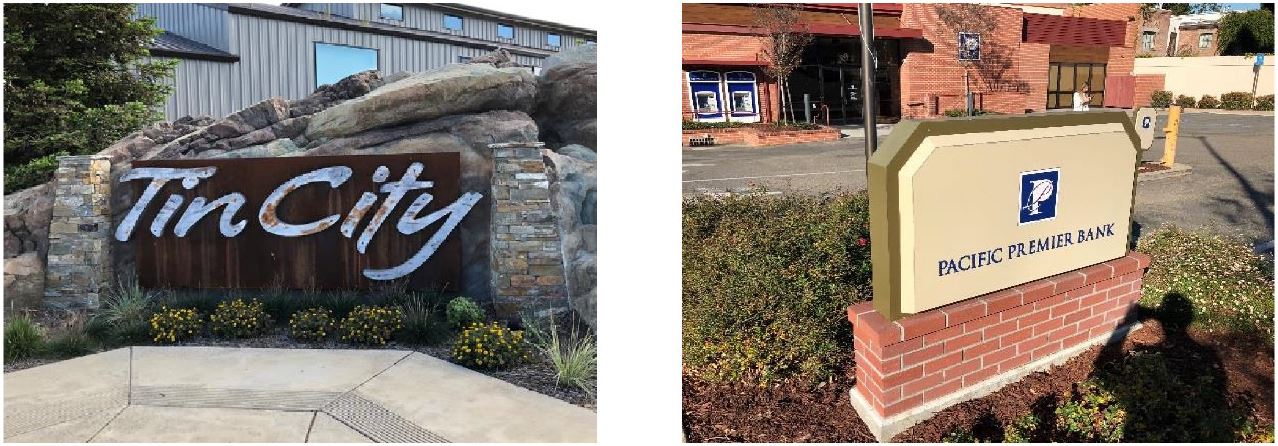
Signage Guidelines
Monument signs are typically used where building setbacks, orientation or design make it difficult to provide other types of signage, such as wall signs, that are plainly visible to people that are trying to identify a use. Monument signs have a solid base that the sign face is installed upon. These signs should be designed so that the style of the sign and its base are consistent with the architecture of the buildings on the site. They are typically oriented perpendicular to the adjacent street and sidewalk and have a maximum of two parallel sign faces. Monument signs provide opportunities for landscaping to enhance their appearance.
1. Location and Number Permitted. Monument signs may be located in required street yards in all commercial districts and the public facility (PF) zone, subject to the approval of the community development and public works directors, as provided for in Section 15.40.410. Only one monument sign is permitted per premises, per street frontage.
2. Size and Height. Monument signs may be a maximum of twenty-four square feet. The maximum height of a monument sign is six feet from the average natural grade at the base of the sign. In the C-R (retail commercial) and C-D (downtown commercial) zoning districts, the maximum size of a monument sign is twelve square feet and the maximum height is four feet. Where two or more uses are located on the same premises, the sign area for monument signs must be shared. The largest single sign face is used to calculate the area of monument signs.
3. Illumination. If illumination of monument signs is desired, then external illumination or halo lighting is preferred. Internally illuminated monument signs downtown shall be consistent with Section 15.40.430. Internal illumination of monument signs as shown below are not allowed in the office (O) or neighborhood commercial (C-N) zone.

4. Design. Monument signs shall be designed to be compatible with the architecture of the buildings on site with a solid base and background with a maximum of two parallel sides. Materials should be durable and made of quality materials such as wood or metal to convey a sense of quality and permanence. Materials such as foam, poster board, or flat plastic which are usually associated with temporary signage are not permitted.
G. Freestanding Post Signs.
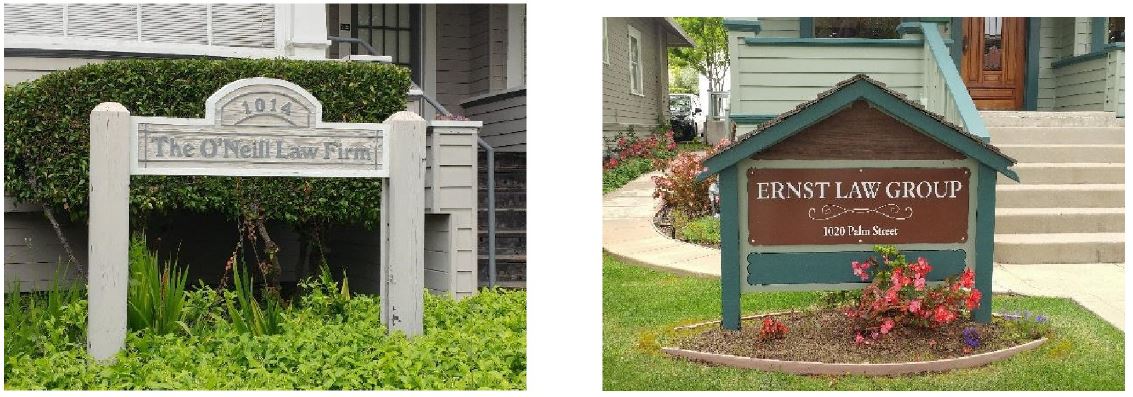
Signage Guidelines
Freestanding post signs are primarily used to identify office uses, especially where a former residence has been converted into an office. They are similar to monument signs, except they do not have a base other than the support posts, they usually have a single sign face, and they are usually oriented parallel to the sidewalk instead of perpendicular. The colors and materials used for the sign must be compatible with the associated building design. Lettering should be carved, routed or applied as opposed to painted on a flat board.
1. Location and Number. Freestanding post signs may be located in required street yards, subject to the approval of the community development and public works directors, as provided for in Section 15.40.410. Only one freestanding post sign is permitted per premises, per street frontage.
2. Size and Height. The maximum sign area for freestanding post signs is twenty square feet. Freestanding post signs shall not be taller than six feet, measured from average natural grade at the base of the sign to the top of the sign structure. Where two or more uses are located on the same premises, the sign area for freestanding post signs must be shared.
3. Illumination. Freestanding post signs may be externally illuminated consistent with Section 15.40.430.
4. Design. Colors and materials used for the sign construction shall include complementary colors and materials with the associated building design and the size and scale of the signs shall not detract or be out of character with the surrounding neighborhood. Materials should be durable and made of quality materials such as wood or metal to convey a sense of quality and permanence. Materials such as foam, poster board, or flat plastic which are usually associated with temporary signage are not permitted.
5. Zoning. Freestanding post signs are allowed in all zoning districts.
H. Pole and Pylon Signs.

Signage Guidelines
Pole signs are primarily intended to communicate with people in automobiles. The sign structure is typically located on a single pole, but other types of supports may be used.
1. Location and Number. Pole and pylon signs may be located along arterial streets and must not impact the line of sight of people in cars to pedestrians or other vehicles in the street right-of-way. They must be located outside of required yard or setback areas, unless an exception is approved by the director during review of the sign design, as provided for by Section 15.40.410. One pole sign is permitted per premises along an arterial street frontage.
2. Size. Pole signs may have a maximum height of sixteen feet and a maximum area of seventy-two square feet measured from the average natural grade of the ground immediately beneath the sign. Where two or more uses are located on the same premises, the sign area for pole signs must be shared on a single sign.
3. Illumination. Pole signs may be illuminated by any means consistent with Section 15.40.430, and subject to approval by the director of the lighting design.
4. Design. Colors and materials used for the sign construction shall include complementary colors and materials with the associated building design.
5. Zoning. Pole signs are allowed in the C-R (retail commercial), C-S (service commercial) and C-T (tourist commercial) zones only along designated arterial routes as identified in the circulation element of the general plan, subject to the approval of the director.
I. A-Frame (Sandwich-Board) Signs.

Signage Guidelines
Sandwich-board signs can be effective for certain types of uses, such as markets, restaurants or bakeries that have changing specials and menus. These signs may have rewritable surfaces, such as chalk boards or dry-erase boards.
1. Location and Number. A-frame (sandwich-board) signs are prohibited in the public right-of-way and must be placed on private property. Sandwich-board signs may be located in required street yards for any given zone, subject to the approval of the community development director, as provided for in Section 15.40.410. They may be placed in a front yard or in a foyer, portico, or other building entry provided they do not interfere with pedestrian ingress or egress as required by the building code. Only one sandwich-board sign is permitted per tenant space.
2. Size. Sandwich-board signs may have a maximum area of eight square feet and a maximum height of four feet, measured from the ground to the top of the sign structure.
3. Illumination. Sandwich-board signs may not be illuminated.
4. Design. Signs must be made of durable materials designed to withstand exterior conditions such as smooth particle board, medium density fiberboard, or plywood.
5. Zoning. Sandwich-board signs are allowed in all commercial zones.
J. Shopping Center (or Multi-Tenant) Identification Signs.
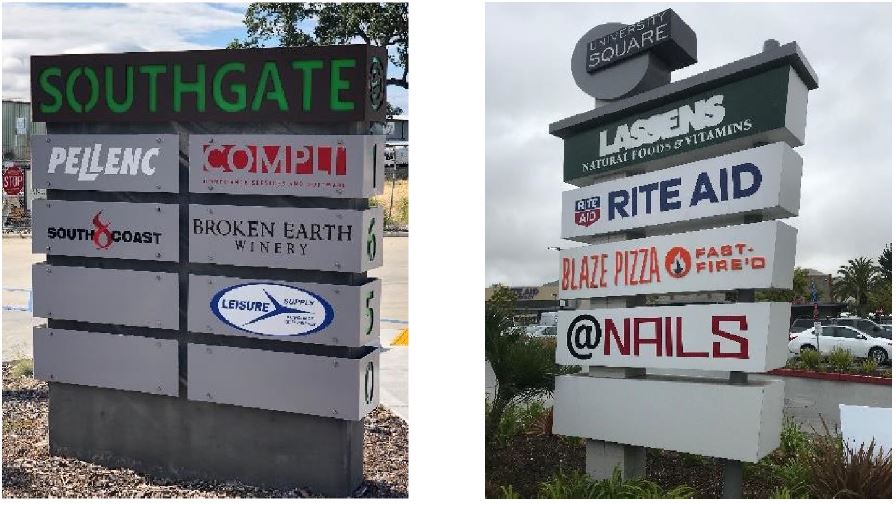
Signage Guidelines
Shopping center identification signs should be compatible with the design theme of the development. They may identify multiple tenants, but larger shopping centers with more than five tenants should avoid listing individual tenants, other than the project anchors, to avoid sign clutter. The sign structure should contain elements of the design theme of the buildings in the center.
1. Location and Number. One shopping center identification sign may be located on each major street frontage of a development subject to approval of the director.
2. Size. Shopping center identification signs for new developments shall be reviewed as part of the development application consistent with Section 15.40.485, Sign programs.
3. Illumination. Shopping center identification signs may be illuminated consistent with Section 15.40.430. Shopping center identification signs shall not incorporate internally illuminated cabinet signs.
4. Design. Shopping center identification signs shall be compatible with the colors, materials, and design theme of the development. Multi-tenant centers with more than five tenants shall only list the main anchor tenants with no more than five listed. Multi-tenant signs which list an excessive number of individual tenants can result in sign clutter.
5. Zoning. Shopping center identification signs shall only be permitted in the C-S, C-C or C-R zoning districts.
K. Flags.
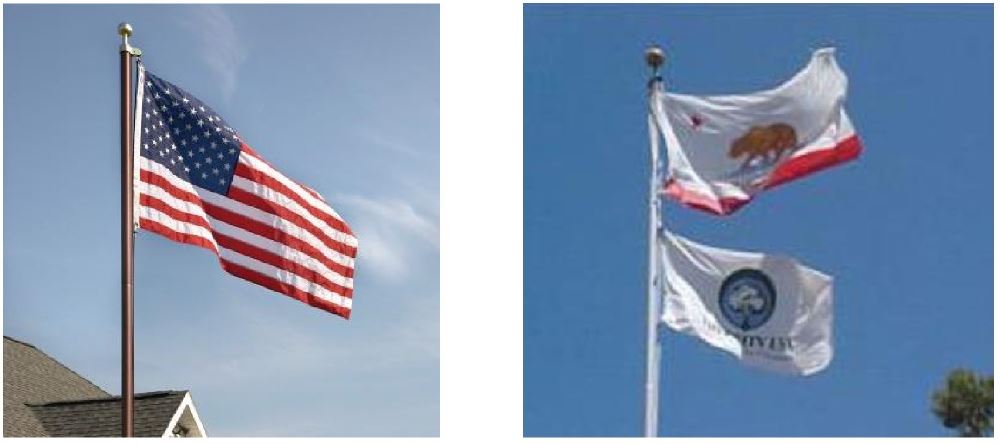
1. Location and Number. Flagpoles shall be located outside of required setback areas. Only one flagpole is permitted per premises. Flagpoles consistent with this section and Section 15.40.200(K) do not require a sign permit but may require building permits. In residential zoning districts wall-mounted flags which do not project above the roofline are exempt from permit requirements.
2. Size. The size (dimensions) of the flag shall be commensurate with the height and diameter of the pole, per recommended industry standards. The maximum height of the flag or pole which the flag is mounted to is the same as the maximum height for structures, as provided in the zoning regulations. Height and size standards for flags are shown in the table below:
|
Ground Set Poles |
Roof-Mounted Poles |
||
|
Exposed Pole Height (ft.) |
Flag Dim. and Size (sq. ft.) |
Exposed Pole Height (ft.) |
Flag Size (sq. ft.) |
|
15—20 |
3 x 5 |
15 |
4 x 6 |
|
25 |
4 x 6 |
20—30 |
5 x 8 |
|
30—35 |
5 x 8 |
35—40 |
6 x 10 |
|
40—45 |
6 x 10 |
45—50 |
8 x 12 |
|
50 |
8 x 12 |
50—60 |
9 x 15 |
3. Illumination. Flags may be illuminated by any means consistent with Section 15.40.430.
4. Zoning. Flags may be located in all zoning districts, subject to conformance with the above size and pole height criteria.
L. Directory Signs.
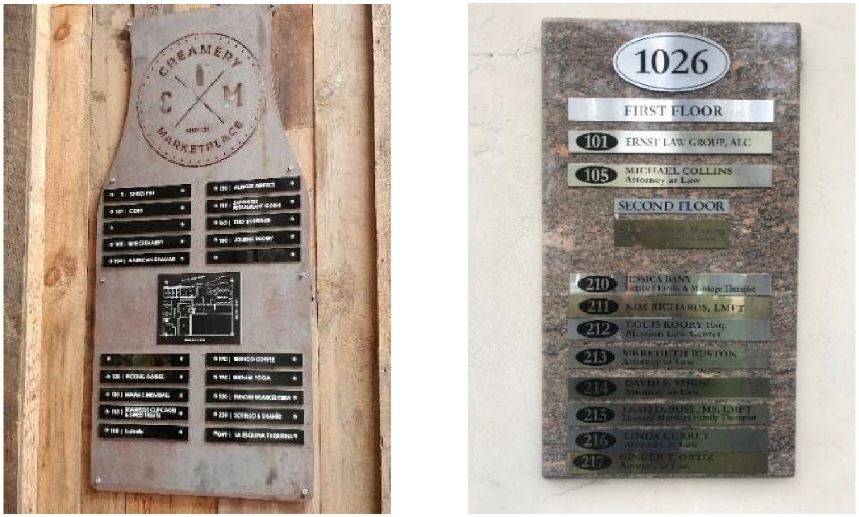
Signage Guidelines
Directory signs are used for multi-tenant buildings to provide a directory of tenant locations within the building. They may also serve as the address sign for the property. Directory signs are small scale and are oriented to pedestrians.
1. Location and Number. Directory signs may be freestanding or may be fixed on an exterior wall if the building has no setback. One directory sign may be permitted per premises.
2. Size. Directory signs may be no larger than twelve square feet in area, and individual letters may not exceed six inches in height.
3. Illumination. Directory signs may be illuminated by any means consistent with Section 15.40.430.
4. Design. Directory signs are intended for multi-tenant buildings to provide visibility and guidance for pedestrians in locating tenant suites. Directory signs are small scale and oriented to pedestrians.
5. Zoning. Directory signs are allowed in all zoning districts. (Ord. 1667 § 3(2) (Exh. A (part)), 2019)